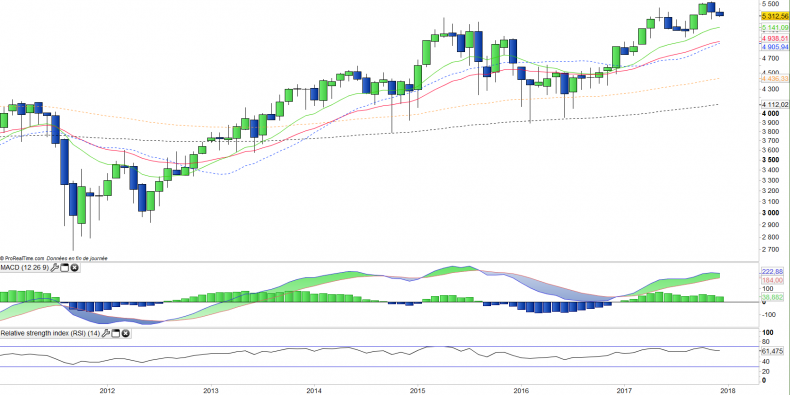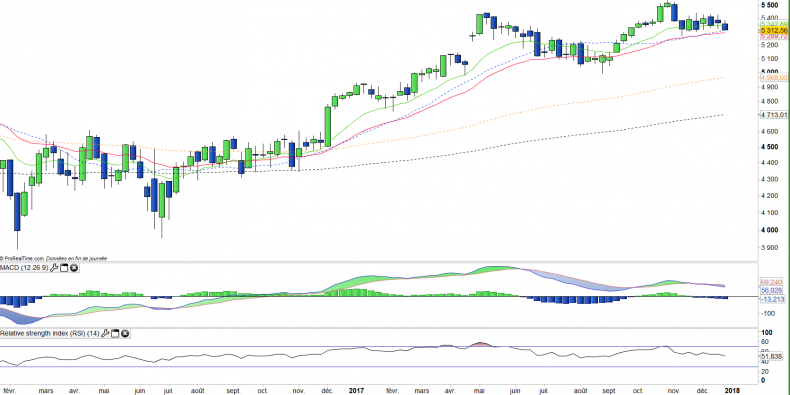Lyxor CAC 40 (CAC) - 02/01/2018
Short Term strategy : Neutral (50%) / Trend -
Long Term strategy : Positive (95%) / Trend -
Charactéristics of the ETF
The CAC ETF (Lyxor) replicates the CAC 40 index, which is composed of the 40 largest French securities representative of the main sectors of the french economy, while the securities are selected and weighted according to the size of their floating market capitalization.
The costs of the ETF CAC are quite low at 0.25% and the AUM is 4 523M €. Replication is direct (physical) and there is a dividend distribution policy.
Alternative ETFs: C4D (Amundi in Euro), E40 (BNP in Euro)
Index & components
It should be noted that the 10 main holdings (which represent about 53% of the index) belong to very different sectors, unlike the DAX (overweight in industrial stocks) or the FTSE100 (pharmacy and financials), the CAC40 is indeed more composite in its sectoral composition. However, two high-weighted stocks, Total (9.4%) and Sanofi (7%), can influence the index according to their own fundamental factors, which represents a bias.
From a sectoral point of view, we can see that the consumer goods sector represented by luxury goods and cosmetics such as LVMH or Loreal, is the most important for the index (19.3%), followed by industry ( 18.2%), financials (14.2%) and energy (9.4%).
The CAC40's stocks are often world leaders with a very international exposure, and little dependence on the domestic market and with a strong sensitivity to the US Dollar.
French macroeconomic statistics have improved significantly since September, but especially the country eliminated a major risk in May with the election of Emmanuel Macron, a liberal and pro-European. The risk premium linked to the disastrous catastrophe scenario in the euro zone began to decline as soon as the first poll results were released, but the positive impact on French growth linked to the election momentum and hopes for structural reforms as well as the lowering of corporate and capital taxes -confirmed for the 2018 budget- are still far from being fully integrated.
France is at the beginning of a new cycle and strong, positive trends could start this time. The medium-term potential of the index is high, as the corporate earnings momentum now seems to have really kicked in after several false starts since 2012 - earnings growth is estimated at around 15% in 2017 and 10% in 2018. Financials should be key, as they could benefit from the gradual rise in long-term rates as growth resumes and higher inflation expectations, as is already the case in the US, coupled with a more favorable political context.
Latest developments
In 2016, the CAC40 achieved a performance of 4.9% and + 9.3% in 2017 but it is still very far from its 2007 levels (6 168 pts) or 2000 (6 945 pts), and is lagging US indices (S&P500: +19.4%) or DAX (+ 12.5%). However, this must be put into perspective by the fact that the CAC40 does not record dividends, which penalizes it by around 3% per year.
Expectations of earnings growth of CAC40 companies are about + 10% for 2018 in an environment of low interest rates and moderate oil prices even if it is on 2-year highs but the rise of the euro compared to the USD at 1.20 is more problematic and could weigh on the index across certain sectors particularly exposed (technology, aeronautics ...).
While valuations remain reasonable (PER 2018 of 15.5x), the CAC40 could appreciate another 10% in 2018, according to the rise in corporate profits without there being has multiple expansion. However, 2018 could prove to be more volatile, because of the risks of consolidation of the US markets because of the rise in rates and high multiples, but also political risks in the first half of the year, in Spain after the victory of the separatists in Catalonia, the difficulties in finding a coalition in Germany and the high-risk Italian elections that will take place on 4 March.
Monthly data
The monthly chart shows a long-term trend that remains clearly bullish, confirming the upward direction of moving averages and the MACD. The current phase is a consolidation towards the 13/36 moving averages which stand 2 to 3% lower, and could therefore continue for some time without jeopardizing the underlying trend.
A rebound should occur in contact with the EMA13, which should be around 5 180 pts in January.
Weekly data
On the weekly chart, we can observe a deterioration of the medium term technical configuration which is expressed through the reversal of the MACD and the flattening of moving averages. However, we must relativize this degradation, which is actually a trading range between 5300 and 5400 pts. As long as these two range lines are not crossed, the short-term trend will remain non-directional.
The potential for variation of the index seems quite limited in the short term and the underlying trend remains bullish.
ETF Objective
CAC is a UCITS ETF which replicates the CAC40 French index (40 companies)
Characteristics
| Inception date | 13/12/2000 |
| Expense ratio | 0,25% |
| Issuer | Lyxor |
| Benchmark | CAC 40 index (PX1) |
| code/ticker | CAC |
| ISIN | FR0007052782 |
| UCITS | Yes |
| EU-SD Status | Out of scope |
| Currency | EUR |
| Exchange | Euronext Paris |
| Assets Under Management | 4 523 M€ |
| Replication Method | Direct (Physical) |
| PEA | Yes |
| SRD | Yes |
| Dividend | Distribution |
| Currency Risk | No |
| Number of Holdings | 40 |
| Global Risk | 3/5 |
Country Breakdown
| France | 94% |
| Switzerland | 3% |
| Luxembourg | 2% |
| United Kingdom | 1% |
| Belgium | 1% |
Sector Breakdown
| Consumer Discretionary | 19% |
| Industrials | 18% |
| Financials | 14% |
| Consumer staples | 11% |
| Energy | 9% |
| Health Care | 9% |
| Materials | 8% |
| Others | 11% |
Top Ten Holdings
| Total SA | 9% |
| Sanofi | 7% |
| BNP Paribas | 6% |
| LVMH | 6% |
| AXA | 4% |
| L'Oréal | 4% |
| Air Liquide | 4% |
| Airbus | 4% |
| Vinci | 4% |
| Danone | 4% |


